Final Accounts for Sole Traders and Partnerships - ACC 101, Semester 1
VerifiedAdded on 2020/10/22
|20
|4820
|483
Report
AI Summary
This report provides a detailed examination of final accounts for sole traders and partnerships. It begins by outlining the necessity and procedures involved in preparing final accounts, including closing entries and trial balance generation. The report then delves into accounting records for incomplete data, methods for constructing accounts, and the impact of incorrect double entries. It further explores the components of final accounts for sole traders, including the statement of profit or loss and the statement of financial position. The report also covers the legislative and accounting requirements for partnerships, focusing on partnership agreements, accounts, the statement of profit or loss appropriation account, and the preparation of capital and current accounts. Finally, it discusses the statement of financial position related to a partnership, including the calculation of closing balances and the preparation of the financial position statement, all in compliance with partnership agreements. The report concludes by summarizing the key aspects of preparing final accounts for sole traders and partnerships.
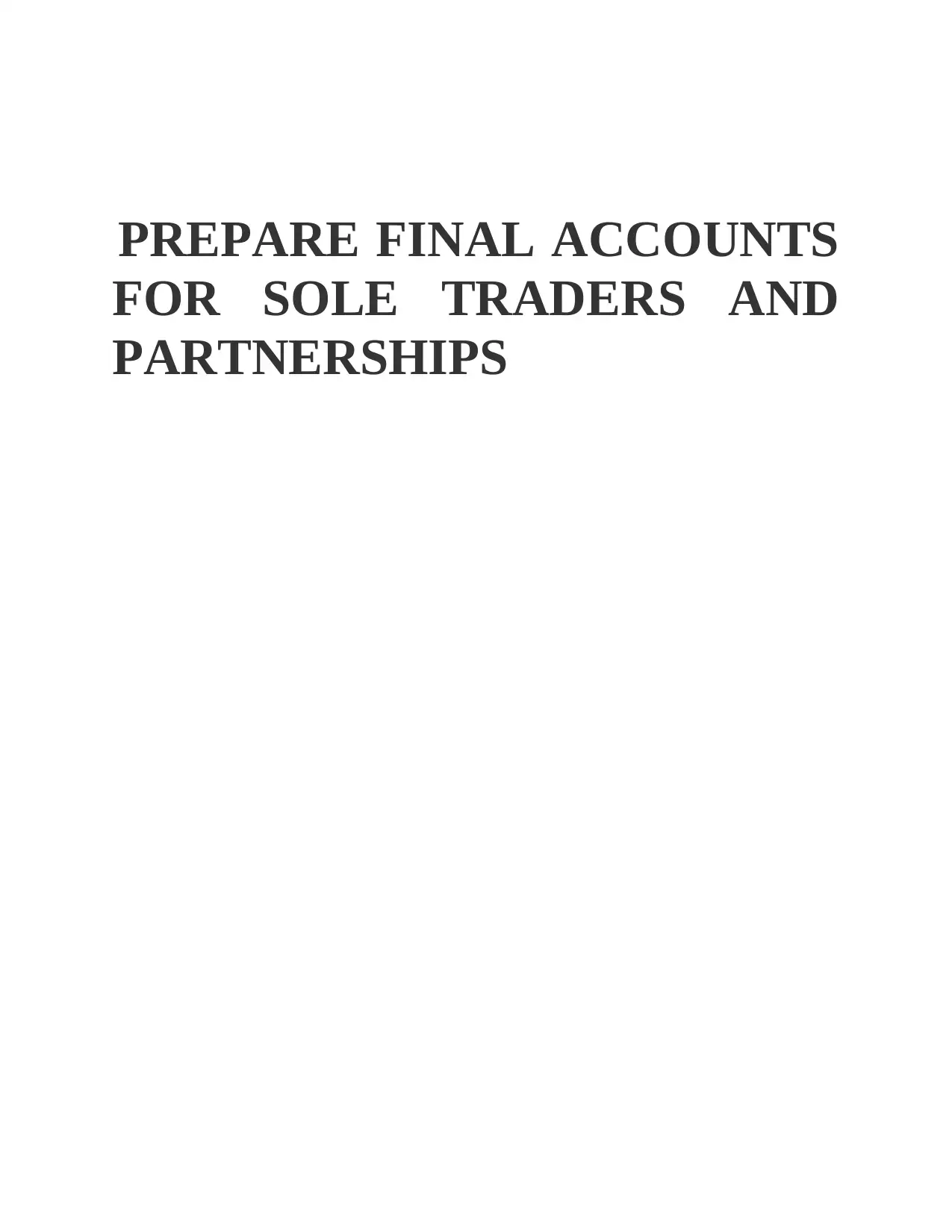
PREPARE FINAL ACCOUNTS
FOR SOLE TRADERS AND
PARTNERSHIPS
FOR SOLE TRADERS AND
PARTNERSHIPS
Paraphrase This Document
Need a fresh take? Get an instant paraphrase of this document with our AI Paraphraser
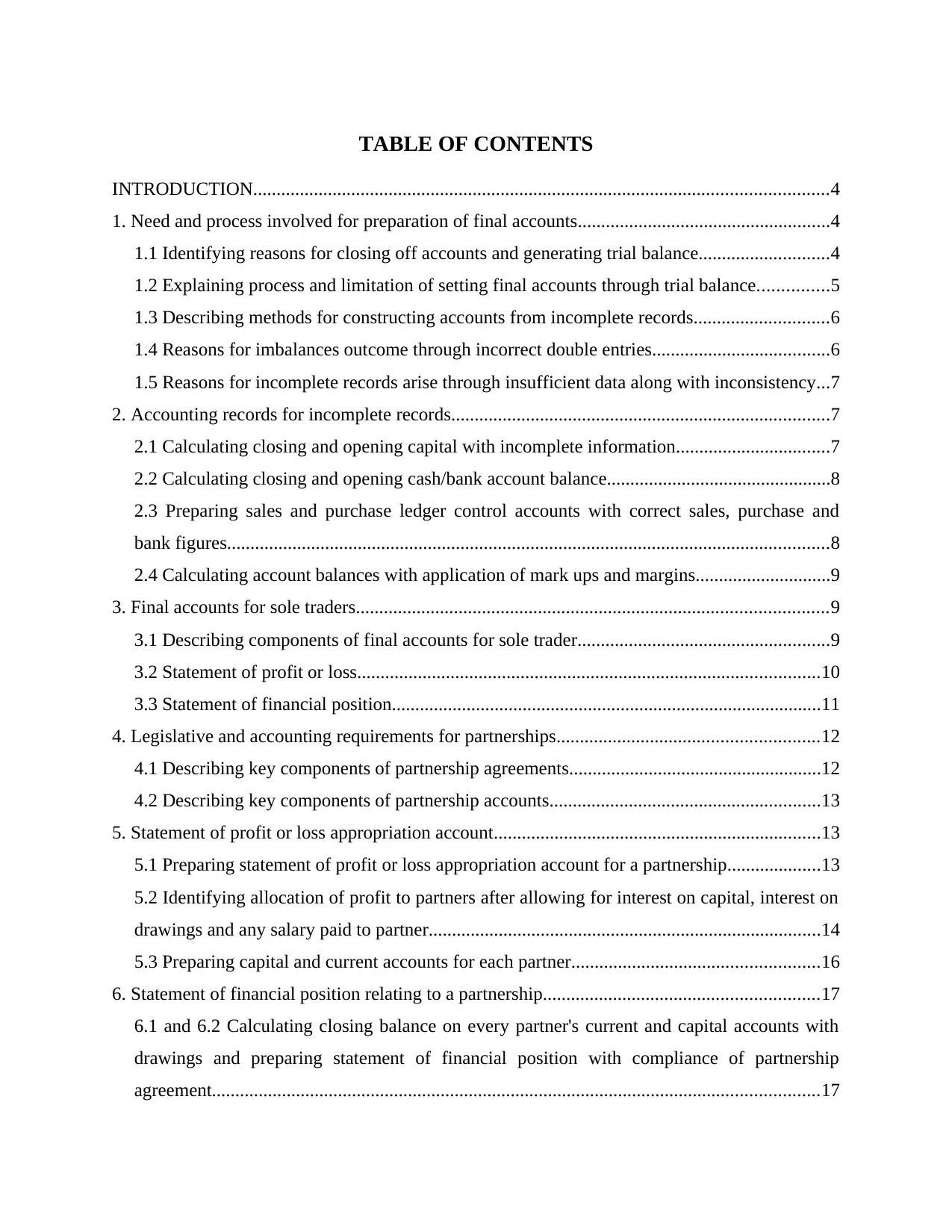
TABLE OF CONTENTS
INTRODUCTION...........................................................................................................................4
1. Need and process involved for preparation of final accounts......................................................4
1.1 Identifying reasons for closing off accounts and generating trial balance............................4
1.2 Explaining process and limitation of setting final accounts through trial balance...............5
1.3 Describing methods for constructing accounts from incomplete records.............................6
1.4 Reasons for imbalances outcome through incorrect double entries......................................6
1.5 Reasons for incomplete records arise through insufficient data along with inconsistency...7
2. Accounting records for incomplete records.................................................................................7
2.1 Calculating closing and opening capital with incomplete information.................................7
2.2 Calculating closing and opening cash/bank account balance................................................8
2.3 Preparing sales and purchase ledger control accounts with correct sales, purchase and
bank figures.................................................................................................................................8
2.4 Calculating account balances with application of mark ups and margins.............................9
3. Final accounts for sole traders.....................................................................................................9
3.1 Describing components of final accounts for sole trader......................................................9
3.2 Statement of profit or loss...................................................................................................10
3.3 Statement of financial position............................................................................................11
4. Legislative and accounting requirements for partnerships........................................................12
4.1 Describing key components of partnership agreements......................................................12
4.2 Describing key components of partnership accounts..........................................................13
5. Statement of profit or loss appropriation account......................................................................13
5.1 Preparing statement of profit or loss appropriation account for a partnership....................13
5.2 Identifying allocation of profit to partners after allowing for interest on capital, interest on
drawings and any salary paid to partner....................................................................................14
5.3 Preparing capital and current accounts for each partner.....................................................16
6. Statement of financial position relating to a partnership...........................................................17
6.1 and 6.2 Calculating closing balance on every partner's current and capital accounts with
drawings and preparing statement of financial position with compliance of partnership
agreement..................................................................................................................................17
INTRODUCTION...........................................................................................................................4
1. Need and process involved for preparation of final accounts......................................................4
1.1 Identifying reasons for closing off accounts and generating trial balance............................4
1.2 Explaining process and limitation of setting final accounts through trial balance...............5
1.3 Describing methods for constructing accounts from incomplete records.............................6
1.4 Reasons for imbalances outcome through incorrect double entries......................................6
1.5 Reasons for incomplete records arise through insufficient data along with inconsistency...7
2. Accounting records for incomplete records.................................................................................7
2.1 Calculating closing and opening capital with incomplete information.................................7
2.2 Calculating closing and opening cash/bank account balance................................................8
2.3 Preparing sales and purchase ledger control accounts with correct sales, purchase and
bank figures.................................................................................................................................8
2.4 Calculating account balances with application of mark ups and margins.............................9
3. Final accounts for sole traders.....................................................................................................9
3.1 Describing components of final accounts for sole trader......................................................9
3.2 Statement of profit or loss...................................................................................................10
3.3 Statement of financial position............................................................................................11
4. Legislative and accounting requirements for partnerships........................................................12
4.1 Describing key components of partnership agreements......................................................12
4.2 Describing key components of partnership accounts..........................................................13
5. Statement of profit or loss appropriation account......................................................................13
5.1 Preparing statement of profit or loss appropriation account for a partnership....................13
5.2 Identifying allocation of profit to partners after allowing for interest on capital, interest on
drawings and any salary paid to partner....................................................................................14
5.3 Preparing capital and current accounts for each partner.....................................................16
6. Statement of financial position relating to a partnership...........................................................17
6.1 and 6.2 Calculating closing balance on every partner's current and capital accounts with
drawings and preparing statement of financial position with compliance of partnership
agreement..................................................................................................................................17
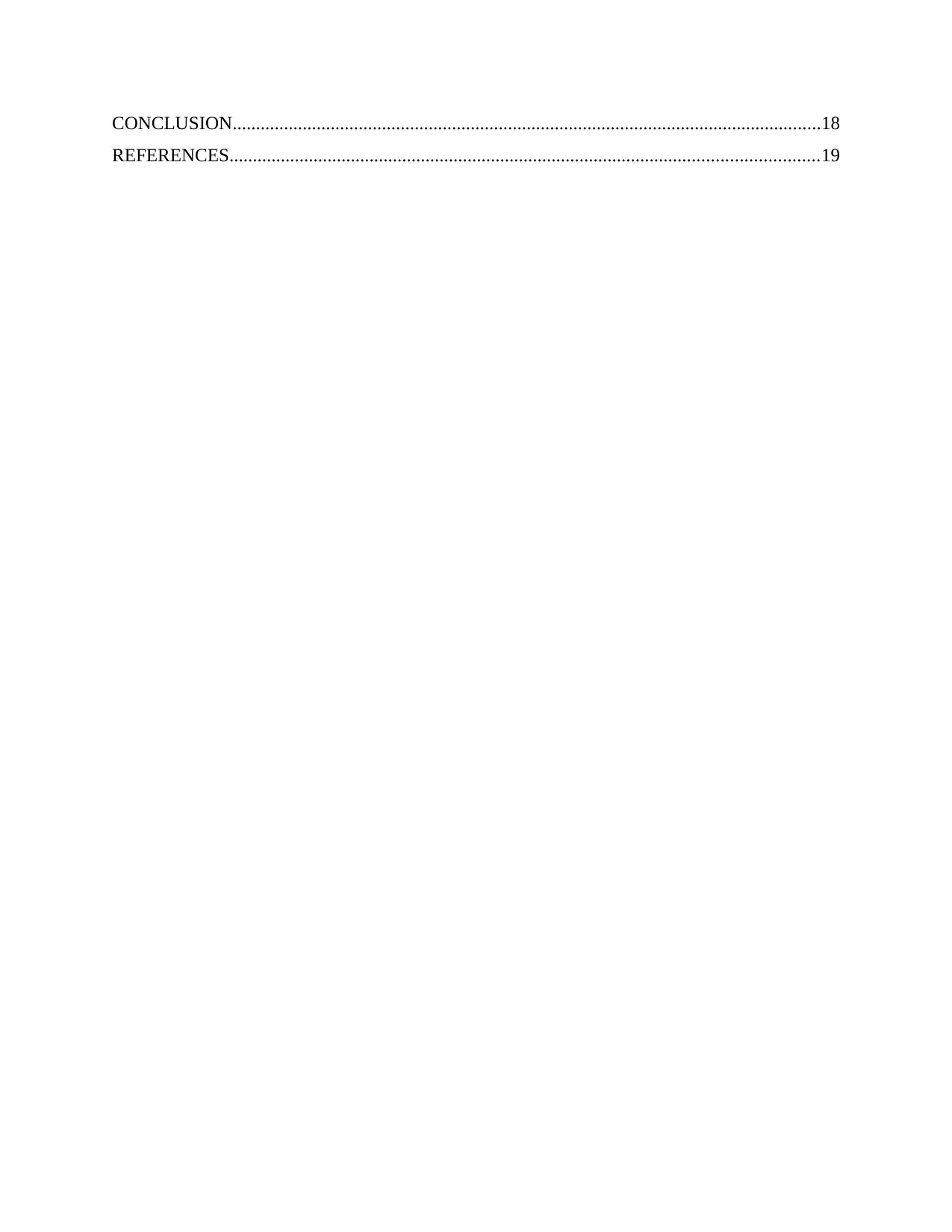
CONCLUSION..............................................................................................................................18
REFERENCES..............................................................................................................................19
REFERENCES..............................................................................................................................19
⊘ This is a preview!⊘
Do you want full access?
Subscribe today to unlock all pages.

Trusted by 1+ million students worldwide
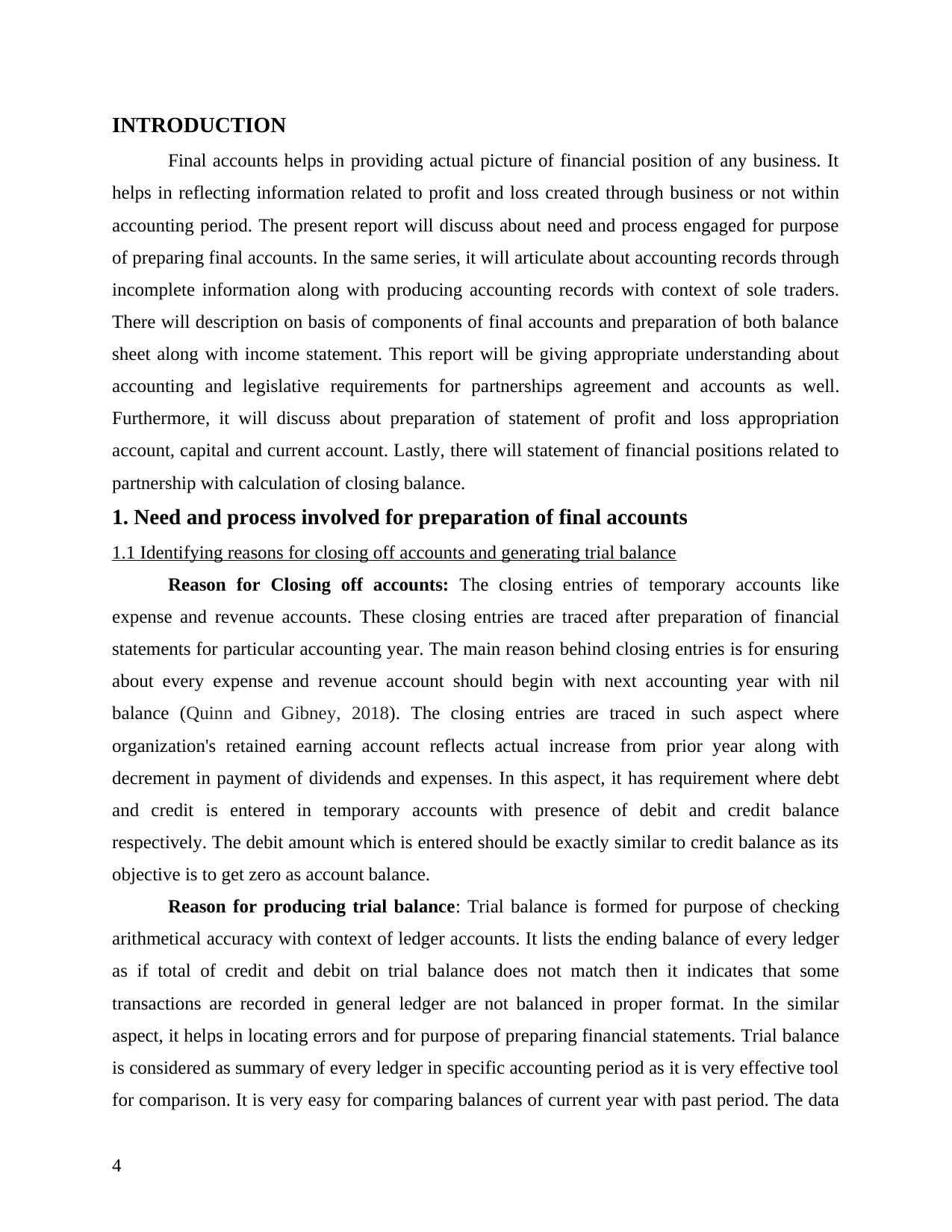
INTRODUCTION
Final accounts helps in providing actual picture of financial position of any business. It
helps in reflecting information related to profit and loss created through business or not within
accounting period. The present report will discuss about need and process engaged for purpose
of preparing final accounts. In the same series, it will articulate about accounting records through
incomplete information along with producing accounting records with context of sole traders.
There will description on basis of components of final accounts and preparation of both balance
sheet along with income statement. This report will be giving appropriate understanding about
accounting and legislative requirements for partnerships agreement and accounts as well.
Furthermore, it will discuss about preparation of statement of profit and loss appropriation
account, capital and current account. Lastly, there will statement of financial positions related to
partnership with calculation of closing balance.
1. Need and process involved for preparation of final accounts
1.1 Identifying reasons for closing off accounts and generating trial balance
Reason for Closing off accounts: The closing entries of temporary accounts like
expense and revenue accounts. These closing entries are traced after preparation of financial
statements for particular accounting year. The main reason behind closing entries is for ensuring
about every expense and revenue account should begin with next accounting year with nil
balance (Quinn and Gibney, 2018). The closing entries are traced in such aspect where
organization's retained earning account reflects actual increase from prior year along with
decrement in payment of dividends and expenses. In this aspect, it has requirement where debt
and credit is entered in temporary accounts with presence of debit and credit balance
respectively. The debit amount which is entered should be exactly similar to credit balance as its
objective is to get zero as account balance.
Reason for producing trial balance: Trial balance is formed for purpose of checking
arithmetical accuracy with context of ledger accounts. It lists the ending balance of every ledger
as if total of credit and debit on trial balance does not match then it indicates that some
transactions are recorded in general ledger are not balanced in proper format. In the similar
aspect, it helps in locating errors and for purpose of preparing financial statements. Trial balance
is considered as summary of every ledger in specific accounting period as it is very effective tool
for comparison. It is very easy for comparing balances of current year with past period. The data
4
Final accounts helps in providing actual picture of financial position of any business. It
helps in reflecting information related to profit and loss created through business or not within
accounting period. The present report will discuss about need and process engaged for purpose
of preparing final accounts. In the same series, it will articulate about accounting records through
incomplete information along with producing accounting records with context of sole traders.
There will description on basis of components of final accounts and preparation of both balance
sheet along with income statement. This report will be giving appropriate understanding about
accounting and legislative requirements for partnerships agreement and accounts as well.
Furthermore, it will discuss about preparation of statement of profit and loss appropriation
account, capital and current account. Lastly, there will statement of financial positions related to
partnership with calculation of closing balance.
1. Need and process involved for preparation of final accounts
1.1 Identifying reasons for closing off accounts and generating trial balance
Reason for Closing off accounts: The closing entries of temporary accounts like
expense and revenue accounts. These closing entries are traced after preparation of financial
statements for particular accounting year. The main reason behind closing entries is for ensuring
about every expense and revenue account should begin with next accounting year with nil
balance (Quinn and Gibney, 2018). The closing entries are traced in such aspect where
organization's retained earning account reflects actual increase from prior year along with
decrement in payment of dividends and expenses. In this aspect, it has requirement where debt
and credit is entered in temporary accounts with presence of debit and credit balance
respectively. The debit amount which is entered should be exactly similar to credit balance as its
objective is to get zero as account balance.
Reason for producing trial balance: Trial balance is formed for purpose of checking
arithmetical accuracy with context of ledger accounts. It lists the ending balance of every ledger
as if total of credit and debit on trial balance does not match then it indicates that some
transactions are recorded in general ledger are not balanced in proper format. In the similar
aspect, it helps in locating errors and for purpose of preparing financial statements. Trial balance
is considered as summary of every ledger in specific accounting period as it is very effective tool
for comparison. It is very easy for comparing balances of current year with past period. The data
4
Paraphrase This Document
Need a fresh take? Get an instant paraphrase of this document with our AI Paraphraser
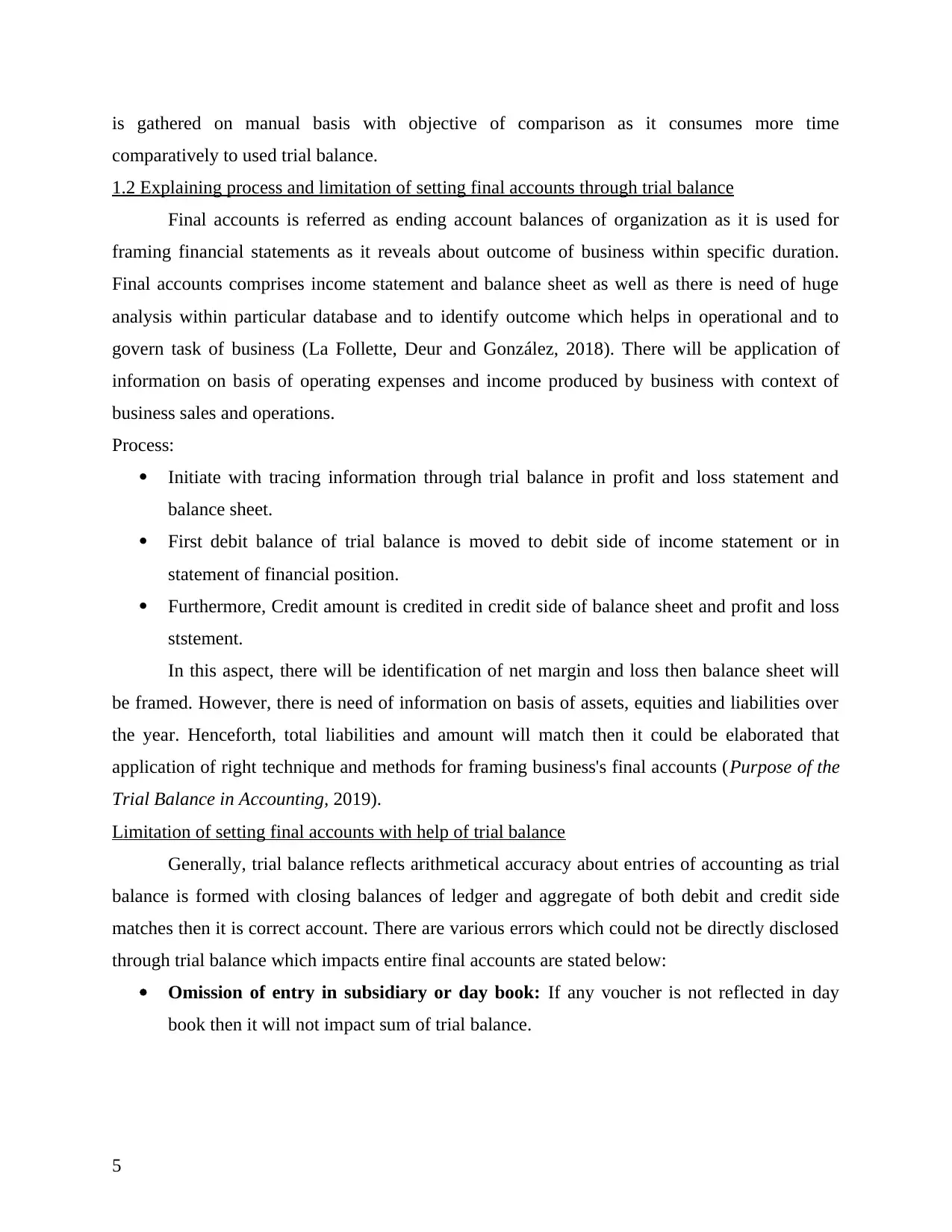
is gathered on manual basis with objective of comparison as it consumes more time
comparatively to used trial balance.
1.2 Explaining process and limitation of setting final accounts through trial balance
Final accounts is referred as ending account balances of organization as it is used for
framing financial statements as it reveals about outcome of business within specific duration.
Final accounts comprises income statement and balance sheet as well as there is need of huge
analysis within particular database and to identify outcome which helps in operational and to
govern task of business (La Follette, Deur and González, 2018). There will be application of
information on basis of operating expenses and income produced by business with context of
business sales and operations.
Process:
Initiate with tracing information through trial balance in profit and loss statement and
balance sheet.
First debit balance of trial balance is moved to debit side of income statement or in
statement of financial position.
Furthermore, Credit amount is credited in credit side of balance sheet and profit and loss
ststement.
In this aspect, there will be identification of net margin and loss then balance sheet will
be framed. However, there is need of information on basis of assets, equities and liabilities over
the year. Henceforth, total liabilities and amount will match then it could be elaborated that
application of right technique and methods for framing business's final accounts (Purpose of the
Trial Balance in Accounting, 2019).
Limitation of setting final accounts with help of trial balance
Generally, trial balance reflects arithmetical accuracy about entries of accounting as trial
balance is formed with closing balances of ledger and aggregate of both debit and credit side
matches then it is correct account. There are various errors which could not be directly disclosed
through trial balance which impacts entire final accounts are stated below:
Omission of entry in subsidiary or day book: If any voucher is not reflected in day
book then it will not impact sum of trial balance.
5
comparatively to used trial balance.
1.2 Explaining process and limitation of setting final accounts through trial balance
Final accounts is referred as ending account balances of organization as it is used for
framing financial statements as it reveals about outcome of business within specific duration.
Final accounts comprises income statement and balance sheet as well as there is need of huge
analysis within particular database and to identify outcome which helps in operational and to
govern task of business (La Follette, Deur and González, 2018). There will be application of
information on basis of operating expenses and income produced by business with context of
business sales and operations.
Process:
Initiate with tracing information through trial balance in profit and loss statement and
balance sheet.
First debit balance of trial balance is moved to debit side of income statement or in
statement of financial position.
Furthermore, Credit amount is credited in credit side of balance sheet and profit and loss
ststement.
In this aspect, there will be identification of net margin and loss then balance sheet will
be framed. However, there is need of information on basis of assets, equities and liabilities over
the year. Henceforth, total liabilities and amount will match then it could be elaborated that
application of right technique and methods for framing business's final accounts (Purpose of the
Trial Balance in Accounting, 2019).
Limitation of setting final accounts with help of trial balance
Generally, trial balance reflects arithmetical accuracy about entries of accounting as trial
balance is formed with closing balances of ledger and aggregate of both debit and credit side
matches then it is correct account. There are various errors which could not be directly disclosed
through trial balance which impacts entire final accounts are stated below:
Omission of entry in subsidiary or day book: If any voucher is not reflected in day
book then it will not impact sum of trial balance.
5
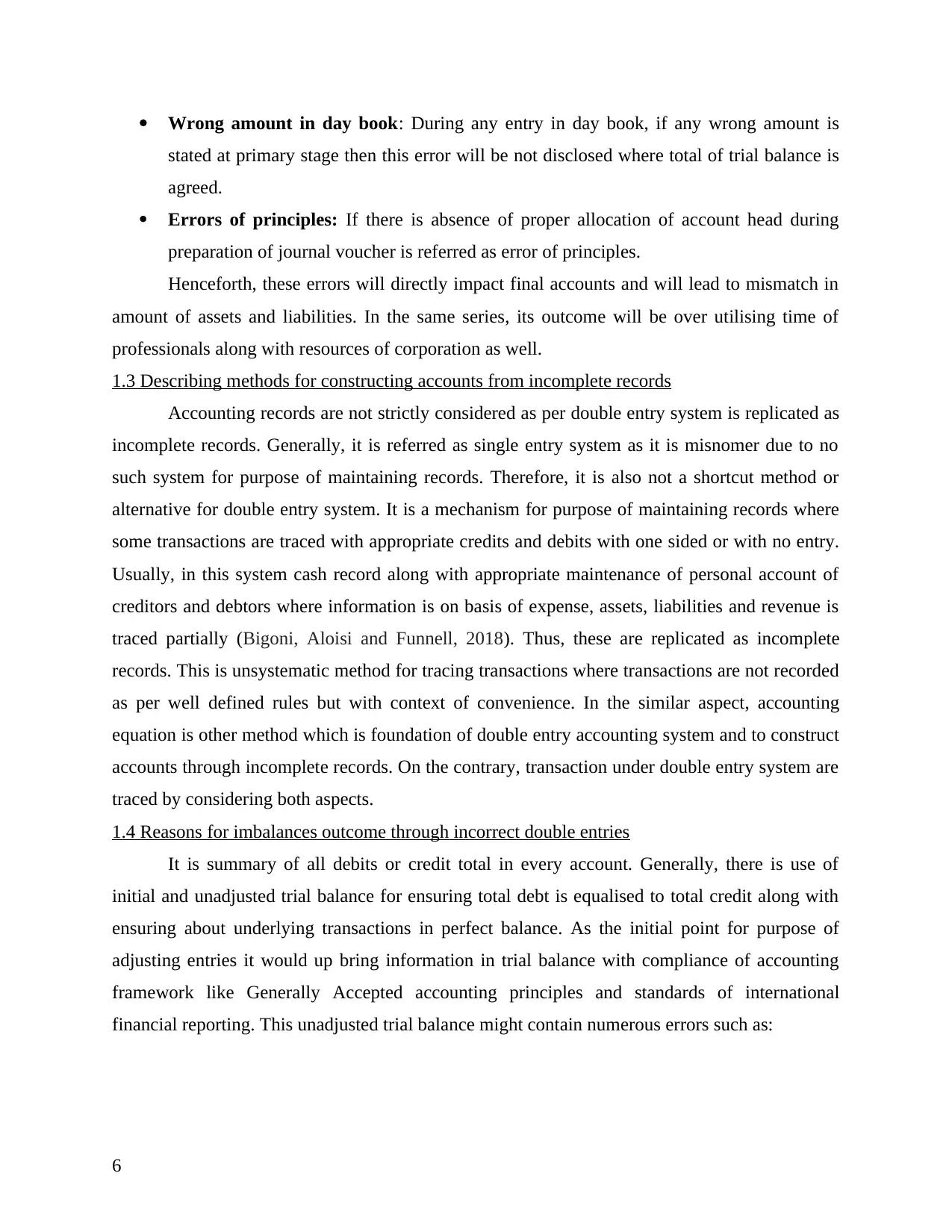
Wrong amount in day book: During any entry in day book, if any wrong amount is
stated at primary stage then this error will be not disclosed where total of trial balance is
agreed.
Errors of principles: If there is absence of proper allocation of account head during
preparation of journal voucher is referred as error of principles.
Henceforth, these errors will directly impact final accounts and will lead to mismatch in
amount of assets and liabilities. In the same series, its outcome will be over utilising time of
professionals along with resources of corporation as well.
1.3 Describing methods for constructing accounts from incomplete records
Accounting records are not strictly considered as per double entry system is replicated as
incomplete records. Generally, it is referred as single entry system as it is misnomer due to no
such system for purpose of maintaining records. Therefore, it is also not a shortcut method or
alternative for double entry system. It is a mechanism for purpose of maintaining records where
some transactions are traced with appropriate credits and debits with one sided or with no entry.
Usually, in this system cash record along with appropriate maintenance of personal account of
creditors and debtors where information is on basis of expense, assets, liabilities and revenue is
traced partially (Bigoni, Aloisi and Funnell, 2018). Thus, these are replicated as incomplete
records. This is unsystematic method for tracing transactions where transactions are not recorded
as per well defined rules but with context of convenience. In the similar aspect, accounting
equation is other method which is foundation of double entry accounting system and to construct
accounts through incomplete records. On the contrary, transaction under double entry system are
traced by considering both aspects.
1.4 Reasons for imbalances outcome through incorrect double entries
It is summary of all debits or credit total in every account. Generally, there is use of
initial and unadjusted trial balance for ensuring total debt is equalised to total credit along with
ensuring about underlying transactions in perfect balance. As the initial point for purpose of
adjusting entries it would up bring information in trial balance with compliance of accounting
framework like Generally Accepted accounting principles and standards of international
financial reporting. This unadjusted trial balance might contain numerous errors such as:
6
stated at primary stage then this error will be not disclosed where total of trial balance is
agreed.
Errors of principles: If there is absence of proper allocation of account head during
preparation of journal voucher is referred as error of principles.
Henceforth, these errors will directly impact final accounts and will lead to mismatch in
amount of assets and liabilities. In the same series, its outcome will be over utilising time of
professionals along with resources of corporation as well.
1.3 Describing methods for constructing accounts from incomplete records
Accounting records are not strictly considered as per double entry system is replicated as
incomplete records. Generally, it is referred as single entry system as it is misnomer due to no
such system for purpose of maintaining records. Therefore, it is also not a shortcut method or
alternative for double entry system. It is a mechanism for purpose of maintaining records where
some transactions are traced with appropriate credits and debits with one sided or with no entry.
Usually, in this system cash record along with appropriate maintenance of personal account of
creditors and debtors where information is on basis of expense, assets, liabilities and revenue is
traced partially (Bigoni, Aloisi and Funnell, 2018). Thus, these are replicated as incomplete
records. This is unsystematic method for tracing transactions where transactions are not recorded
as per well defined rules but with context of convenience. In the similar aspect, accounting
equation is other method which is foundation of double entry accounting system and to construct
accounts through incomplete records. On the contrary, transaction under double entry system are
traced by considering both aspects.
1.4 Reasons for imbalances outcome through incorrect double entries
It is summary of all debits or credit total in every account. Generally, there is use of
initial and unadjusted trial balance for ensuring total debt is equalised to total credit along with
ensuring about underlying transactions in perfect balance. As the initial point for purpose of
adjusting entries it would up bring information in trial balance with compliance of accounting
framework like Generally Accepted accounting principles and standards of international
financial reporting. This unadjusted trial balance might contain numerous errors such as:
6
⊘ This is a preview!⊘
Do you want full access?
Subscribe today to unlock all pages.

Trusted by 1+ million students worldwide
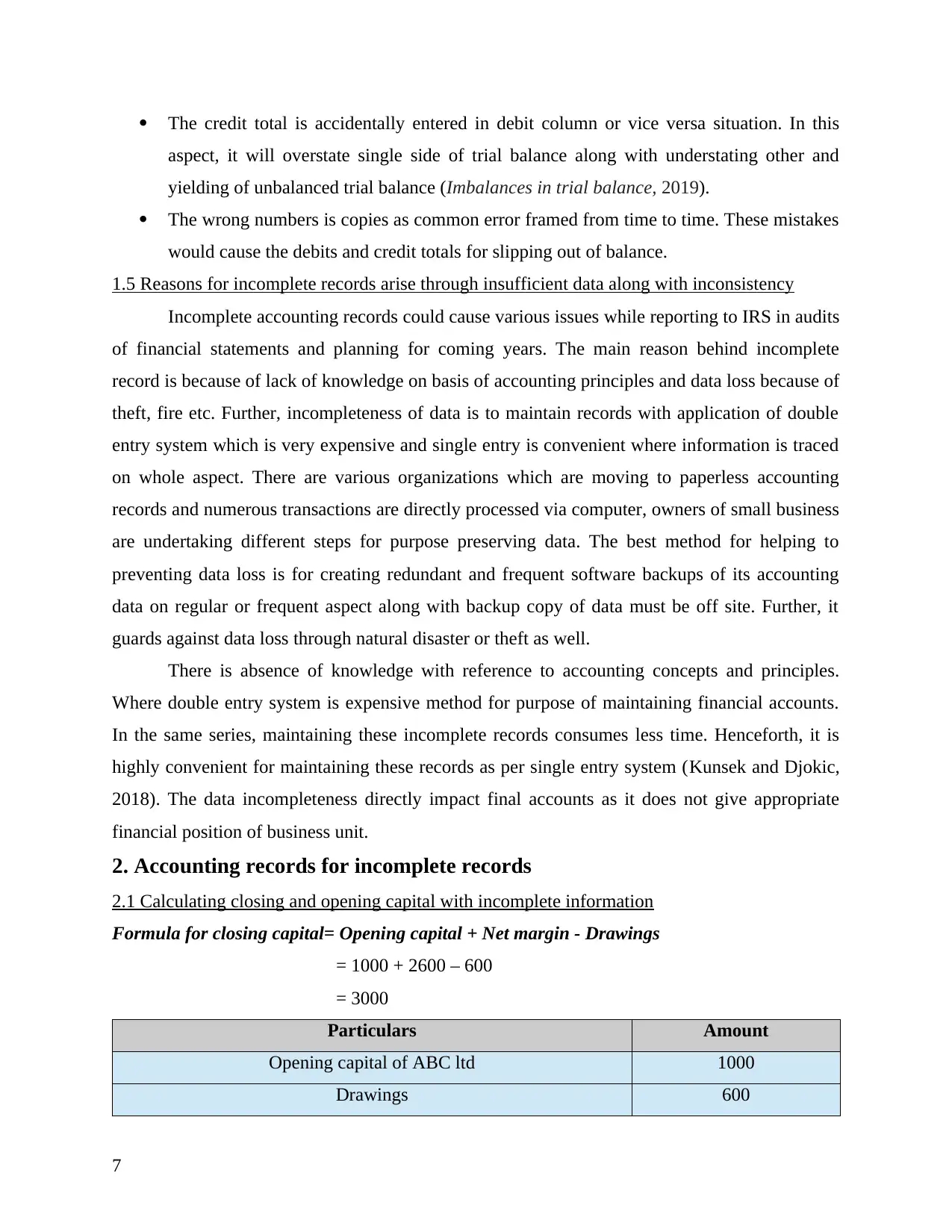
The credit total is accidentally entered in debit column or vice versa situation. In this
aspect, it will overstate single side of trial balance along with understating other and
yielding of unbalanced trial balance (Imbalances in trial balance, 2019).
The wrong numbers is copies as common error framed from time to time. These mistakes
would cause the debits and credit totals for slipping out of balance.
1.5 Reasons for incomplete records arise through insufficient data along with inconsistency
Incomplete accounting records could cause various issues while reporting to IRS in audits
of financial statements and planning for coming years. The main reason behind incomplete
record is because of lack of knowledge on basis of accounting principles and data loss because of
theft, fire etc. Further, incompleteness of data is to maintain records with application of double
entry system which is very expensive and single entry is convenient where information is traced
on whole aspect. There are various organizations which are moving to paperless accounting
records and numerous transactions are directly processed via computer, owners of small business
are undertaking different steps for purpose preserving data. The best method for helping to
preventing data loss is for creating redundant and frequent software backups of its accounting
data on regular or frequent aspect along with backup copy of data must be off site. Further, it
guards against data loss through natural disaster or theft as well.
There is absence of knowledge with reference to accounting concepts and principles.
Where double entry system is expensive method for purpose of maintaining financial accounts.
In the same series, maintaining these incomplete records consumes less time. Henceforth, it is
highly convenient for maintaining these records as per single entry system (Kunsek and Djokic,
2018). The data incompleteness directly impact final accounts as it does not give appropriate
financial position of business unit.
2. Accounting records for incomplete records
2.1 Calculating closing and opening capital with incomplete information
Formula for closing capital= Opening capital + Net margin - Drawings
= 1000 + 2600 – 600
= 3000
Particulars Amount
Opening capital of ABC ltd 1000
Drawings 600
7
aspect, it will overstate single side of trial balance along with understating other and
yielding of unbalanced trial balance (Imbalances in trial balance, 2019).
The wrong numbers is copies as common error framed from time to time. These mistakes
would cause the debits and credit totals for slipping out of balance.
1.5 Reasons for incomplete records arise through insufficient data along with inconsistency
Incomplete accounting records could cause various issues while reporting to IRS in audits
of financial statements and planning for coming years. The main reason behind incomplete
record is because of lack of knowledge on basis of accounting principles and data loss because of
theft, fire etc. Further, incompleteness of data is to maintain records with application of double
entry system which is very expensive and single entry is convenient where information is traced
on whole aspect. There are various organizations which are moving to paperless accounting
records and numerous transactions are directly processed via computer, owners of small business
are undertaking different steps for purpose preserving data. The best method for helping to
preventing data loss is for creating redundant and frequent software backups of its accounting
data on regular or frequent aspect along with backup copy of data must be off site. Further, it
guards against data loss through natural disaster or theft as well.
There is absence of knowledge with reference to accounting concepts and principles.
Where double entry system is expensive method for purpose of maintaining financial accounts.
In the same series, maintaining these incomplete records consumes less time. Henceforth, it is
highly convenient for maintaining these records as per single entry system (Kunsek and Djokic,
2018). The data incompleteness directly impact final accounts as it does not give appropriate
financial position of business unit.
2. Accounting records for incomplete records
2.1 Calculating closing and opening capital with incomplete information
Formula for closing capital= Opening capital + Net margin - Drawings
= 1000 + 2600 – 600
= 3000
Particulars Amount
Opening capital of ABC ltd 1000
Drawings 600
7
Paraphrase This Document
Need a fresh take? Get an instant paraphrase of this document with our AI Paraphraser
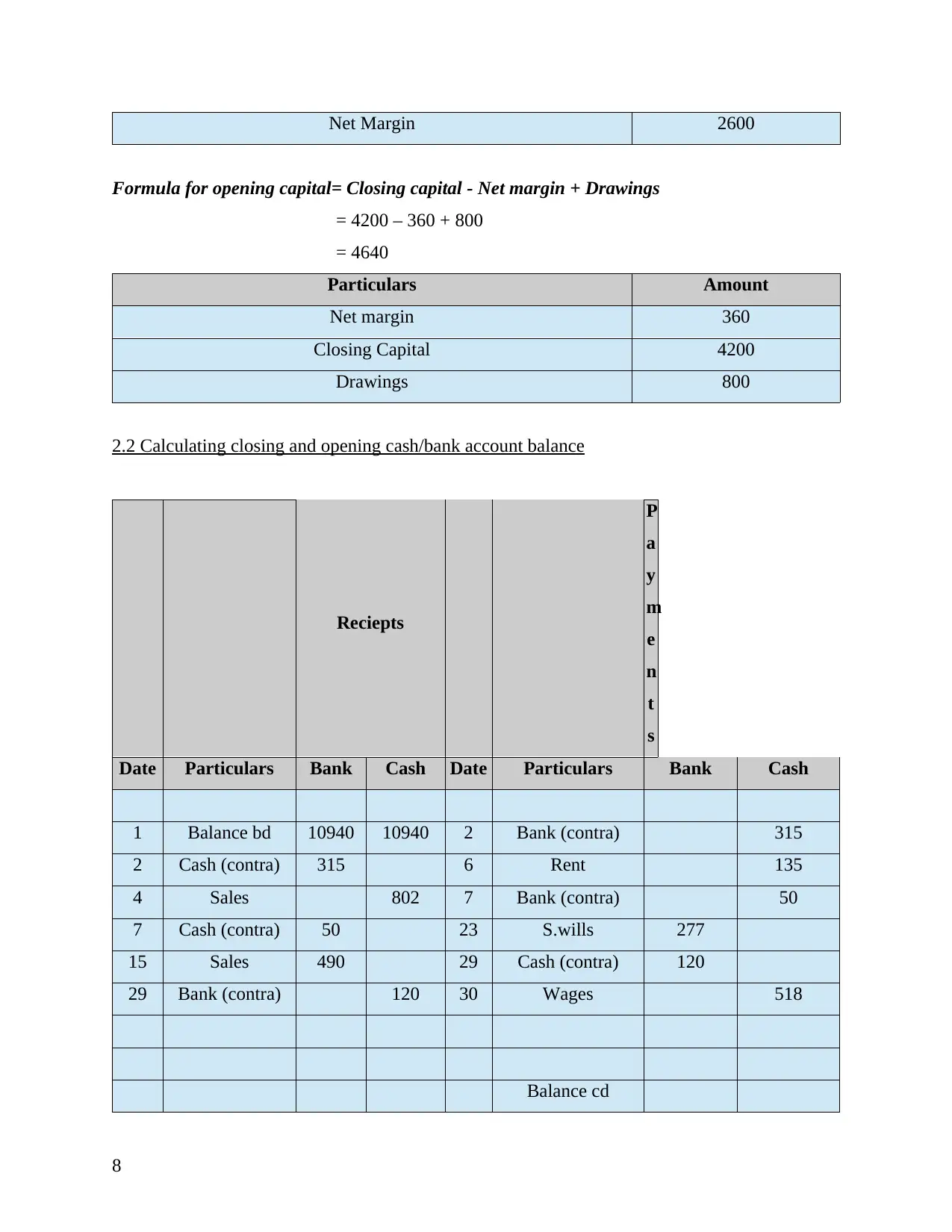
Net Margin 2600
Formula for opening capital= Closing capital - Net margin + Drawings
= 4200 – 360 + 800
= 4640
Particulars Amount
Net margin 360
Closing Capital 4200
Drawings 800
2.2 Calculating closing and opening cash/bank account balance
Reciepts
P
a
y
m
e
n
t
s
Date Particulars Bank Cash Date Particulars Bank Cash
1 Balance bd 10940 10940 2 Bank (contra) 315
2 Cash (contra) 315 6 Rent 135
4 Sales 802 7 Bank (contra) 50
7 Cash (contra) 50 23 S.wills 277
15 Sales 490 29 Cash (contra) 120
29 Bank (contra) 120 30 Wages 518
Balance cd
8
Formula for opening capital= Closing capital - Net margin + Drawings
= 4200 – 360 + 800
= 4640
Particulars Amount
Net margin 360
Closing Capital 4200
Drawings 800
2.2 Calculating closing and opening cash/bank account balance
Reciepts
P
a
y
m
e
n
t
s
Date Particulars Bank Cash Date Particulars Bank Cash
1 Balance bd 10940 10940 2 Bank (contra) 315
2 Cash (contra) 315 6 Rent 135
4 Sales 802 7 Bank (contra) 50
7 Cash (contra) 50 23 S.wills 277
15 Sales 490 29 Cash (contra) 120
29 Bank (contra) 120 30 Wages 518
Balance cd
8
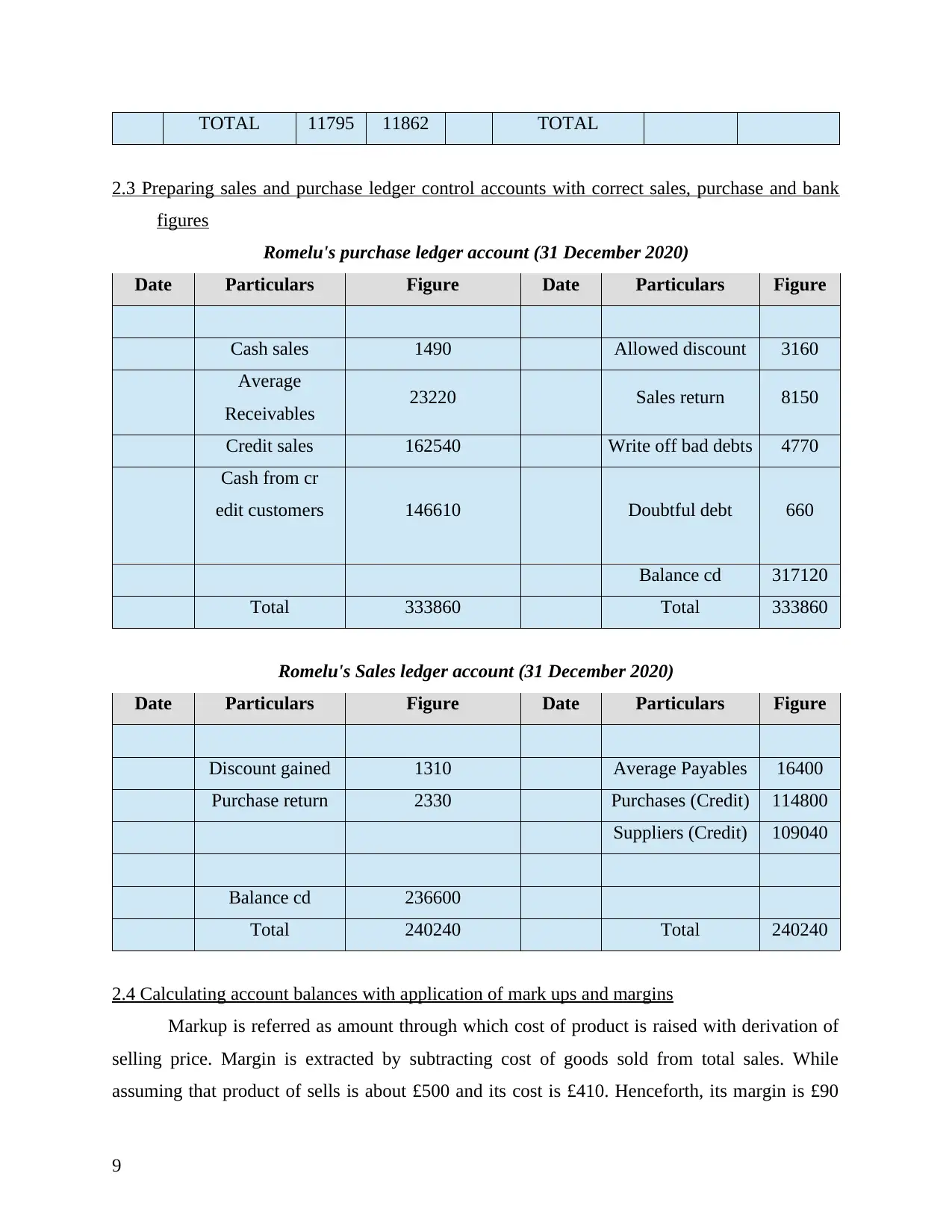
TOTAL 11795 11862 TOTAL
2.3 Preparing sales and purchase ledger control accounts with correct sales, purchase and bank
figures
Romelu's purchase ledger account (31 December 2020)
Date Particulars Figure Date Particulars Figure
Cash sales 1490 Allowed discount 3160
Average
Receivables 23220 Sales return 8150
Credit sales 162540 Write off bad debts 4770
Cash from cr
edit customers 146610 Doubtful debt 660
Balance cd 317120
Total 333860 Total 333860
Romelu's Sales ledger account (31 December 2020)
Date Particulars Figure Date Particulars Figure
Discount gained 1310 Average Payables 16400
Purchase return 2330 Purchases (Credit) 114800
Suppliers (Credit) 109040
Balance cd 236600
Total 240240 Total 240240
2.4 Calculating account balances with application of mark ups and margins
Markup is referred as amount through which cost of product is raised with derivation of
selling price. Margin is extracted by subtracting cost of goods sold from total sales. While
assuming that product of sells is about £500 and its cost is £410. Henceforth, its margin is £90
9
2.3 Preparing sales and purchase ledger control accounts with correct sales, purchase and bank
figures
Romelu's purchase ledger account (31 December 2020)
Date Particulars Figure Date Particulars Figure
Cash sales 1490 Allowed discount 3160
Average
Receivables 23220 Sales return 8150
Credit sales 162540 Write off bad debts 4770
Cash from cr
edit customers 146610 Doubtful debt 660
Balance cd 317120
Total 333860 Total 333860
Romelu's Sales ledger account (31 December 2020)
Date Particulars Figure Date Particulars Figure
Discount gained 1310 Average Payables 16400
Purchase return 2330 Purchases (Credit) 114800
Suppliers (Credit) 109040
Balance cd 236600
Total 240240 Total 240240
2.4 Calculating account balances with application of mark ups and margins
Markup is referred as amount through which cost of product is raised with derivation of
selling price. Margin is extracted by subtracting cost of goods sold from total sales. While
assuming that product of sells is about £500 and its cost is £410. Henceforth, its margin is £90
9
⊘ This is a preview!⊘
Do you want full access?
Subscribe today to unlock all pages.

Trusted by 1+ million students worldwide
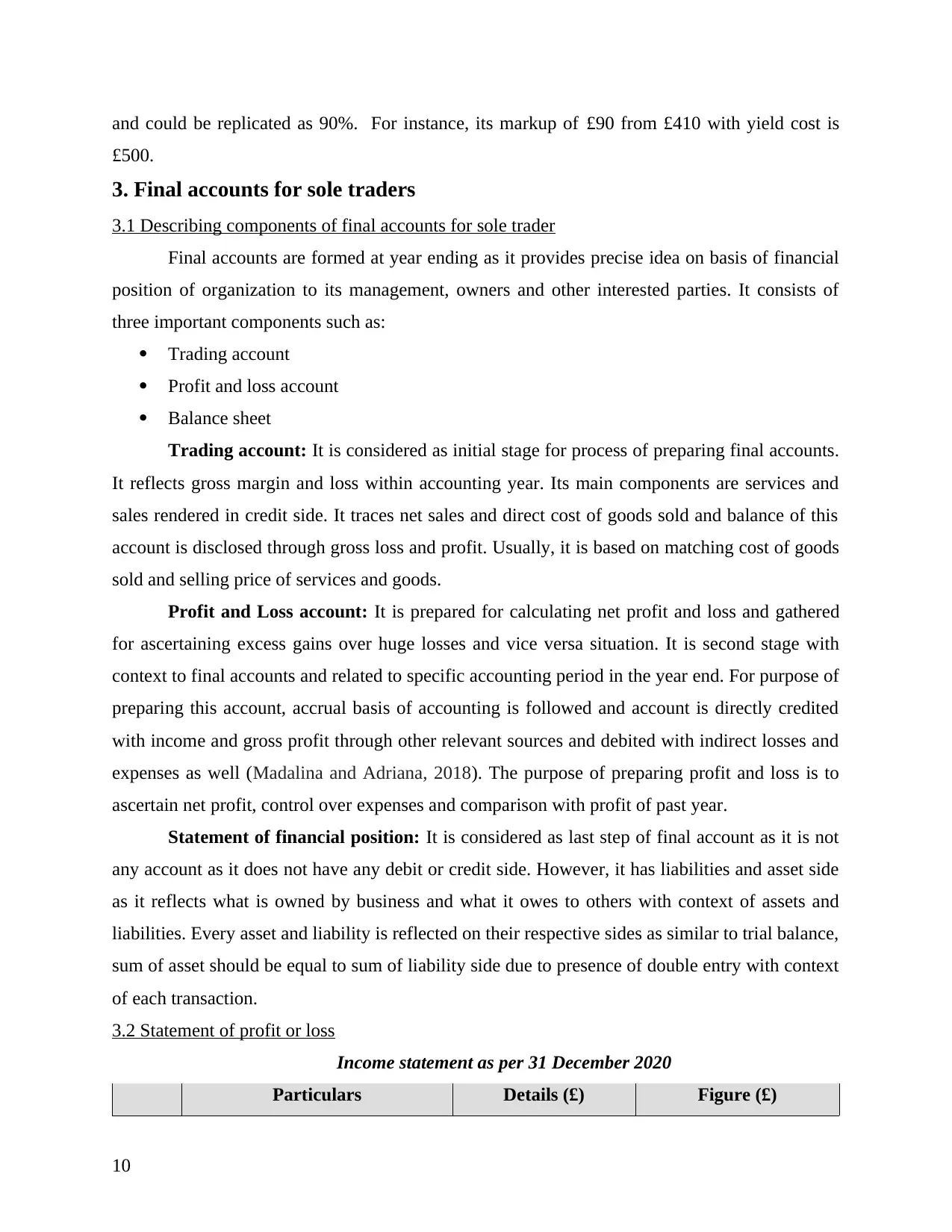
and could be replicated as 90%. For instance, its markup of £90 from £410 with yield cost is
£500.
3. Final accounts for sole traders
3.1 Describing components of final accounts for sole trader
Final accounts are formed at year ending as it provides precise idea on basis of financial
position of organization to its management, owners and other interested parties. It consists of
three important components such as:
Trading account
Profit and loss account
Balance sheet
Trading account: It is considered as initial stage for process of preparing final accounts.
It reflects gross margin and loss within accounting year. Its main components are services and
sales rendered in credit side. It traces net sales and direct cost of goods sold and balance of this
account is disclosed through gross loss and profit. Usually, it is based on matching cost of goods
sold and selling price of services and goods.
Profit and Loss account: It is prepared for calculating net profit and loss and gathered
for ascertaining excess gains over huge losses and vice versa situation. It is second stage with
context to final accounts and related to specific accounting period in the year end. For purpose of
preparing this account, accrual basis of accounting is followed and account is directly credited
with income and gross profit through other relevant sources and debited with indirect losses and
expenses as well (Madalina and Adriana, 2018). The purpose of preparing profit and loss is to
ascertain net profit, control over expenses and comparison with profit of past year.
Statement of financial position: It is considered as last step of final account as it is not
any account as it does not have any debit or credit side. However, it has liabilities and asset side
as it reflects what is owned by business and what it owes to others with context of assets and
liabilities. Every asset and liability is reflected on their respective sides as similar to trial balance,
sum of asset should be equal to sum of liability side due to presence of double entry with context
of each transaction.
3.2 Statement of profit or loss
Income statement as per 31 December 2020
Particulars Details (£) Figure (£)
10
£500.
3. Final accounts for sole traders
3.1 Describing components of final accounts for sole trader
Final accounts are formed at year ending as it provides precise idea on basis of financial
position of organization to its management, owners and other interested parties. It consists of
three important components such as:
Trading account
Profit and loss account
Balance sheet
Trading account: It is considered as initial stage for process of preparing final accounts.
It reflects gross margin and loss within accounting year. Its main components are services and
sales rendered in credit side. It traces net sales and direct cost of goods sold and balance of this
account is disclosed through gross loss and profit. Usually, it is based on matching cost of goods
sold and selling price of services and goods.
Profit and Loss account: It is prepared for calculating net profit and loss and gathered
for ascertaining excess gains over huge losses and vice versa situation. It is second stage with
context to final accounts and related to specific accounting period in the year end. For purpose of
preparing this account, accrual basis of accounting is followed and account is directly credited
with income and gross profit through other relevant sources and debited with indirect losses and
expenses as well (Madalina and Adriana, 2018). The purpose of preparing profit and loss is to
ascertain net profit, control over expenses and comparison with profit of past year.
Statement of financial position: It is considered as last step of final account as it is not
any account as it does not have any debit or credit side. However, it has liabilities and asset side
as it reflects what is owned by business and what it owes to others with context of assets and
liabilities. Every asset and liability is reflected on their respective sides as similar to trial balance,
sum of asset should be equal to sum of liability side due to presence of double entry with context
of each transaction.
3.2 Statement of profit or loss
Income statement as per 31 December 2020
Particulars Details (£) Figure (£)
10
Paraphrase This Document
Need a fresh take? Get an instant paraphrase of this document with our AI Paraphraser
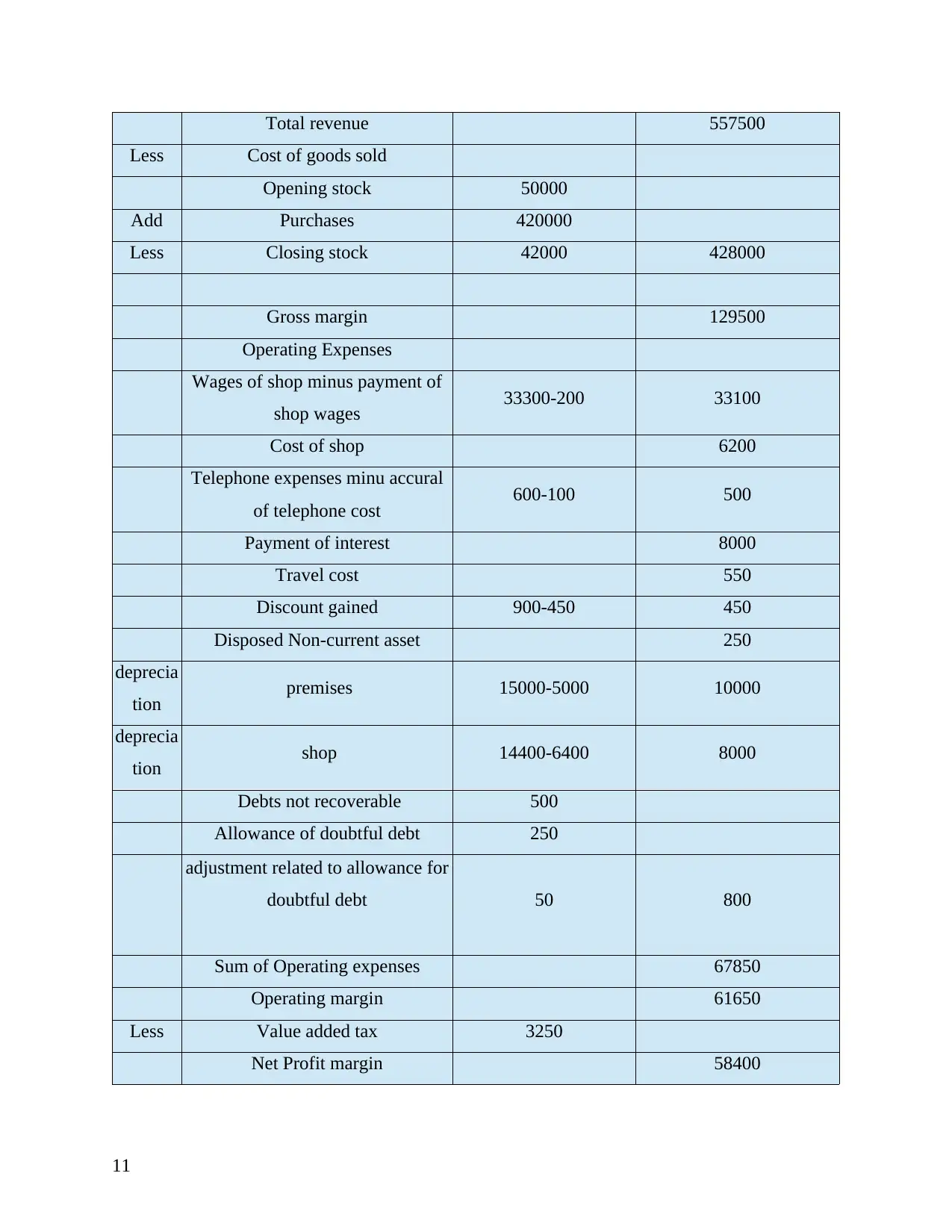
Total revenue 557500
Less Cost of goods sold
Opening stock 50000
Add Purchases 420000
Less Closing stock 42000 428000
Gross margin 129500
Operating Expenses
Wages of shop minus payment of
shop wages 33300-200 33100
Cost of shop 6200
Telephone expenses minu accural
of telephone cost 600-100 500
Payment of interest 8000
Travel cost 550
Discount gained 900-450 450
Disposed Non-current asset 250
deprecia
tion premises 15000-5000 10000
deprecia
tion shop 14400-6400 8000
Debts not recoverable 500
Allowance of doubtful debt 250
adjustment related to allowance for
doubtful debt 50 800
Sum of Operating expenses 67850
Operating margin 61650
Less Value added tax 3250
Net Profit margin 58400
11
Less Cost of goods sold
Opening stock 50000
Add Purchases 420000
Less Closing stock 42000 428000
Gross margin 129500
Operating Expenses
Wages of shop minus payment of
shop wages 33300-200 33100
Cost of shop 6200
Telephone expenses minu accural
of telephone cost 600-100 500
Payment of interest 8000
Travel cost 550
Discount gained 900-450 450
Disposed Non-current asset 250
deprecia
tion premises 15000-5000 10000
deprecia
tion shop 14400-6400 8000
Debts not recoverable 500
Allowance of doubtful debt 250
adjustment related to allowance for
doubtful debt 50 800
Sum of Operating expenses 67850
Operating margin 61650
Less Value added tax 3250
Net Profit margin 58400
11
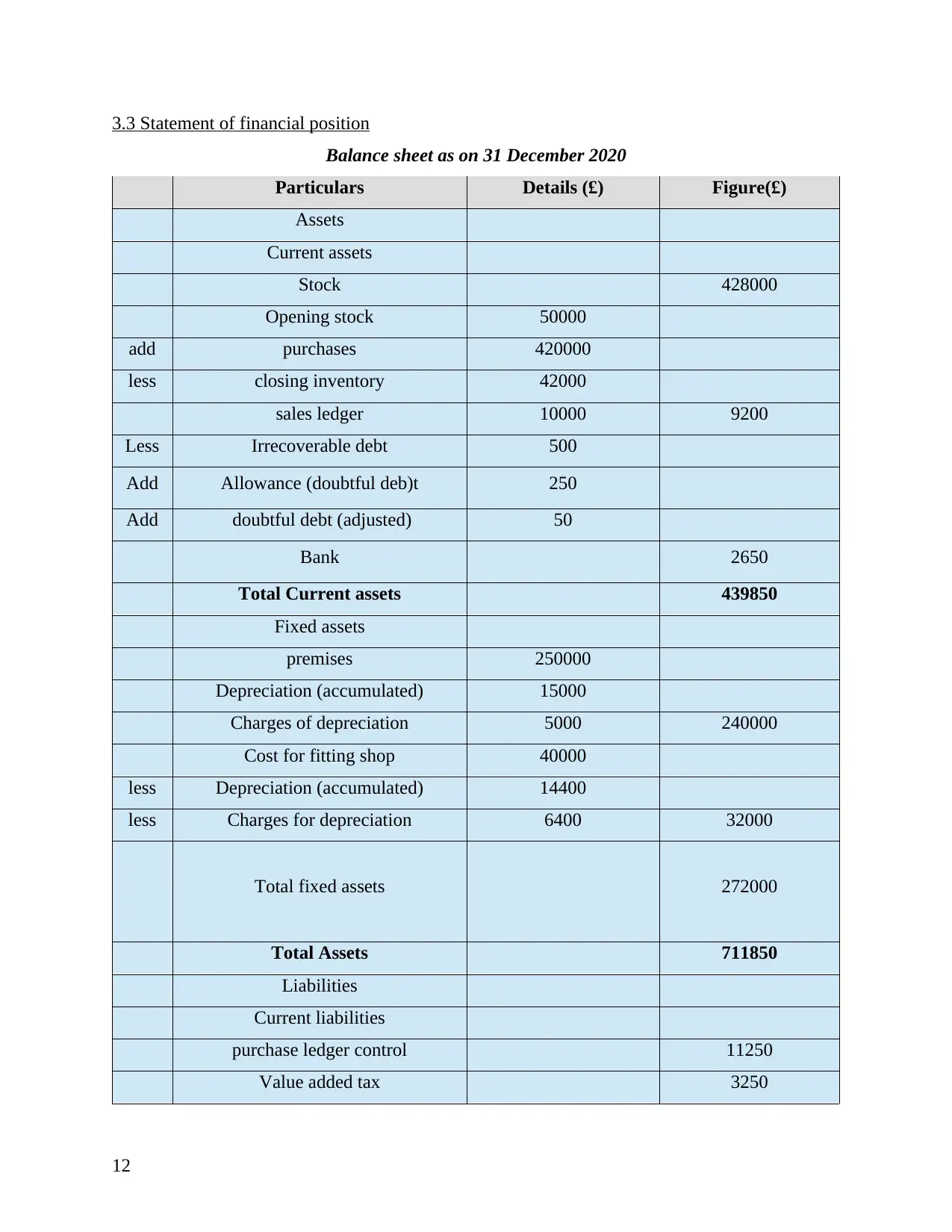
3.3 Statement of financial position
Balance sheet as on 31 December 2020
Particulars Details (£) Figure(£)
Assets
Current assets
Stock 428000
Opening stock 50000
add purchases 420000
less closing inventory 42000
sales ledger 10000 9200
Less Irrecoverable debt 500
Add Allowance (doubtful deb)t 250
Add doubtful debt (adjusted) 50
Bank 2650
Total Current assets 439850
Fixed assets
premises 250000
Depreciation (accumulated) 15000
Charges of depreciation 5000 240000
Cost for fitting shop 40000
less Depreciation (accumulated) 14400
less Charges for depreciation 6400 32000
Total fixed assets 272000
Total Assets 711850
Liabilities
Current liabilities
purchase ledger control 11250
Value added tax 3250
12
Balance sheet as on 31 December 2020
Particulars Details (£) Figure(£)
Assets
Current assets
Stock 428000
Opening stock 50000
add purchases 420000
less closing inventory 42000
sales ledger 10000 9200
Less Irrecoverable debt 500
Add Allowance (doubtful deb)t 250
Add doubtful debt (adjusted) 50
Bank 2650
Total Current assets 439850
Fixed assets
premises 250000
Depreciation (accumulated) 15000
Charges of depreciation 5000 240000
Cost for fitting shop 40000
less Depreciation (accumulated) 14400
less Charges for depreciation 6400 32000
Total fixed assets 272000
Total Assets 711850
Liabilities
Current liabilities
purchase ledger control 11250
Value added tax 3250
12
⊘ This is a preview!⊘
Do you want full access?
Subscribe today to unlock all pages.

Trusted by 1+ million students worldwide
1 out of 20
Related Documents
Your All-in-One AI-Powered Toolkit for Academic Success.
+13062052269
info@desklib.com
Available 24*7 on WhatsApp / Email
![[object Object]](/_next/static/media/star-bottom.7253800d.svg)
Unlock your academic potential
Copyright © 2020–2025 A2Z Services. All Rights Reserved. Developed and managed by ZUCOL.





